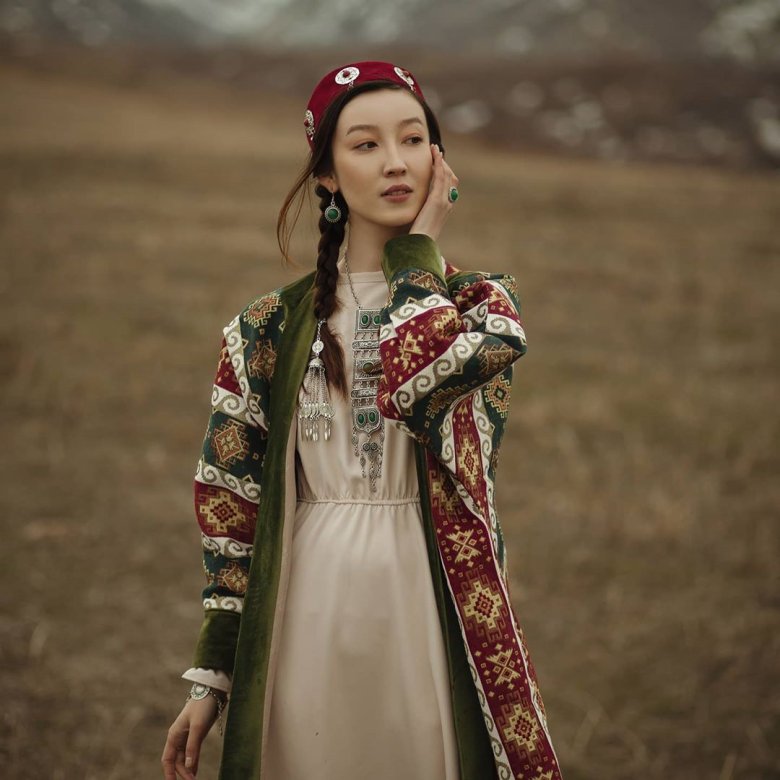ASTANA – In Kazakh tradition, amulets play an important role as talismans that are said to fend against evil and usher in good fortune and benefits. They have ancient origins and reflect the country’s diverse cultural practices.

Tumar amulets in a triangle shape with Kazakh tanba signs. Photo credit: Shezhire Instagram page.
According to Gulzada Shokasheva, a scholar in Asian studies, nomadic ancestors lived in harmony with nature throughout ancient times. They held deep beliefs in its power and the existence of both benevolent and evil spirits.
“They referred to the souls of ancestors as “aruakhs,” considering them benevolent, whereas demons were known as “jinns,” which led to the tradition of creating various protective amulets,” she said.
Kazakh ancestors used geometric shapes like lines, crosses, and circles to represent everything from the sublime to the enigmatic.

Tanba is Kazakh clans and their tribal signs. Photo credit: Shezhire Instagram page.
Shokasheva emphasized the existence of several notable amulets, including tanba, tumar, owl feathers, and silver earrings.
“Kazakhs have a longstanding tradition of wearing tumar as protective amulets around their necks. Eagle owl feathers were commonly attached to children’s cradles and the headdresses of young girls, as it was believed they would ward off the evil eye, spells, and malevolent spirits,” she said.
Dauren Kanzhigalin, the founder of the Shezhire company, crafts handmade products from leather. His interest in studying his own genealogy led him to explore the history of Kazakh clans and their tribal signs, known as tanba.
“Tanbas remains a subject of study for experts. However, it is evident they carry profound meanings and convey a sense of power in various ways. It can be likened to a family coat of arms,” he said.
According to Kanzhigalin, these markings were applied to specific household items, weapons, and livestock, serving as branding to signify their affiliation with a particular Kazakh family.
Tumar’s power
Kanzhigalin also crafts tumar amulets traditionally in a triangle shape, which has sacred properties.

Photo credit: Shezhire Instagram page.
“The vertex of the triangle, whether it pointed up or down, was the most important part of the shape. A triangle with an apex that points upward signified the dynamic male principle, whereas a triangle with a vertex that points downward represented the receptive feminine principle,” said Kanzhigalin.
The triangular form was also a symbol of the ancient Turkic goddess Umay. In the pre-Islamic period, people used to carry a handful of native soil in leather bags to place in graves after death.
When Islam reached the steppes, the significance of tumar transformed, and people started inserting verses from the Holy Quran into these leather pouches.
“Tumar no longer holds the sacred function believed by ancient people. Today it has become more of a decorative accessory. I want to enhance the recognition of Kazakh ornaments and contribute to studying the ancestral tamga, applying it to the front side of my works,” said Kanzhigalin.
He deeply studied ancient Turkic script, which gave him the idea of creating tumar with images of ancient Turkic runes.
“Ancient Turkic writing often includes words that exist in our language today, like “Qyt” (Blessing) and “Baq” (Happiness) – these bright wishes for goodness and happiness, written in ancient Turkic runes, also pay tribute to the ancient writings of our ancestors, serving as symbols of our great past,” he said.
Owl feathers
Kanzhigalin also cited the potency of owl feathers, which nomads believed could guard against evil spirits.
“Kazakhs would tie owl feathers to yurts and cradles of children, sewn onto children’s clothing, wall carpets, and headgear to safeguard from illnesses,” he said.
They were also attached to the dombra (a traditional musical instrument) to protect musicians from the evil eye.
Silver Jewelry
Silver has held significant importance as a talisman in the steppe. The metal’s disinfecting properties have been recognized since ancient times, and it’s no coincidence that Kazakhs used silver in their jewelry.

Silver earrings were always considered as protective talismans, which women wore from childhood throughout their entire lives. Photo credit: uhd.name.
“Silver earrings were always considered to be protective talismans, which women wore from childhood throughout their entire lives,” said Shokasheva.
When someone passed away, all jewelry was removed, except for the earrings. It was believed that if the earrings were taken off, snakes would crawl into the ears.
Shokasheva highlighted that their symbolism enhanced the magical nature of earrings as parts were shaped like snakes, peaks, suns, moons, and spirals.
“Even today, the older generation considers earrings protective amulets, which are an essential part of a bride’s dowry,” she said.
Silver hair ornaments, featuring pendant-shaped objects resembling cones or figures imitating bells, were also meant to ward off evil forces. This sound protected against dark spirits.
Medical opinion
Malika Muratkenova, an internist with 12 years of expertise, claims that the human mind can balance the body by activating certain areas based on the images we conjure up in our minds.

Nomads believed that the sound of hair ornaments protected against dark spirits. Photo credit: uhd.name.
“There is no secret that the power of our thoughts has the potential to overcome some ailment. However, some believe that we need a specific amulet that directs our thoughts towards healing to trigger the recovery processes within our bodies,” she said.
While this belief can sometimes aid patients in adopting a positive mindset toward recovery, it is crucial not to rely solely on it.
“Only a qualified doctor can provide an accurate diagnosis and determine the appropriate treatment,” said Muratkenova.


